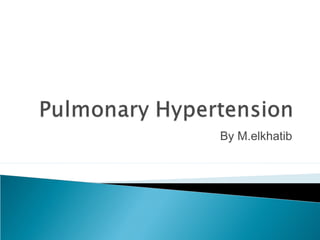Pulmonary hypertension elkhatib
- 2. ’üĮ Understand the physiology of pulmonary hypertension. ’üĮ Understand the signs and symptoms of pulmonary hypertension. ’üĮ Types pulmonary hypertension. ’üĮ Understand the treatment of a pulmonary hypertension and a crisis.
- 3. ŌĆó PPuullmmoonnaarryy hhyyppeerrtteennssiioonn ooccccuurrss wwhheenn tthheerree iiss aabbnnoorrmmaallllyy hhiigghh pprreessssuurree wwiitthhiinn tthhee bblloooodd vveesssseellss ooff tthhee lluunnggss. ŌĆó NNoorrmmaallllyy,, bblloooodd tthhaatt fflloowwss tthhrroouugghh tthheessee vveesssseellss mmeeeettss lliittttllee rreessiissttaannccee,, aass tthheeyy nnaattuurraallllyy wwiiddeenn ttoo aallllooww bblloooodd ffrroomm tthhee hheeaarrtt ttoo ppaassss tthhrroouugghh ssmmooootthhllyy ttoo ppiicckk uupp ooxxyyggeenn aanndd ddeelliivveerr iitt ttoo tthhee bbooddyy..
- 4. ŌĆó IInn ppuullmmoonnaarryy hhyyppeerrtteennssiioonn,, tthhee bblloooodd vveesssseellss ccoonnssttrriicctt,, bbeeccoommiinngg nnaarrrrooww aanndd tthhiicckk.. TThhiiss mmeeaannss lleessss bblloooodd iiss aabbllee ttoo ffllooww tthhrroouugghh tthhee bblloooodd vveesssseellss ŌĆó WWhheenn tthhiiss hhaappppeennss,, pprreessssuurree wwiitthhiinn tthhee vveesssseellss bbuuiillddss uupp aanndd tthhee hheeaarrtt mmuussccllee mmuusstt wwoorrkk hhaarrddeerr ttoo ffoorrccee tthhee bblloooodd tthhrroouugghh..
- 5. ’üĮ WWhheenn tthhee pprreessssuurree bbeeccoommeess ttoooo hhiigghh,, tthhee hheeaarrtt ccaann''tt kkeeeepp uupp aanndd lleessss bblloooodd iiss cciirrccuullaatteedd tthhrroouugghh tthhee lluunnggss.. TThhiiss rreessuullttss iinn lleessss ooxxyyggeenn ttoo tthhee eennttiirree bbooddyy.. ’üĮ Pulmonary Hypertension affects more women then men.
- 7. ’üĮ PPrriimmaarryy ppuullmmoonnaarryy hhyyppeerrtteennssiioonn AAllssoo kknnoowwnn aass iiddiiooppaatthhiicc ppuullmmoonnaarryy hhyyppeerrtteennssiioonn hhaass nnoo iiddeennttiiffiiaabbllee uunnddeerrllyyiinngg ccaauussee.. ’üĮ SSeeccoonnddaarryy ppuullmmoonnaarryy hhyyppeerrtteennssiioonn iiss ddeeffiinneedd aass eelleevvaatteedd ppuullmmoonnaarryy pprreessssuurreess sseeccoonnddaarryy ttoo eeiitthheerr aa ppuullmmoonnaarryy oorr aa ccaarrddiiaacc ddiissoorrddeerr ’üĮ PPeerrssiisstteenntt ppuullmmoonnaarryy hhyyppeerrtteennssiioonn ooff tthhee nneewwbboorrnn ((PPPPHHNN))
- 8. ŌĆóAny condition that causes chronic low oxygen levels in the blood ŌĆóAutoimmune diseases that damage the lungs, such as scleroderma and rheumatoid arthritis ŌĆóCertain birth defects of the heart ŌĆóCertain diet medications ŌĆóCongestive heart failure ŌĆóHistory of a blood clot in the lung ŌĆóHIV infection ŌĆóLung or heart valve disease ŌĆóObstructive sleep apnea
- 9. ’üĮ TTaacchhyyppnnooeeaa ’üĮ IInnccrreeaasseedd WWOOBB((wwoorrkk ooff bbrreeaatthhiinngg)) ’üĮ CCyyaannoossiiss ’üĮ hhyyppooxxiiaa ’üĮ TTaacchhyyccaarrddiiaa ’üĮ Shortness of breath or light-headedness during activity is often the first symptom. ’üĮ Over time, symptoms occur with lighter activity or even while at rest
- 10. ’üĮ Ankle and leg swelling ’üĮ Bluish color of the lips or skin (cyanosis) ’üĮ Chest pain or pressure, usually in the front of the chest ’üĮ Dizziness or fainting spells ’üĮ Fatigue ’üĮ Weakness
- 11. ’üĮ EElleevvaatteedd ppuullmmoonnaarryy aarrtteerryy pprreessssuurree iinn ccoonnggeenniittaall hheeaarrtt ddiisseeaassee iiss ccaauusseedd bbyy ppuullmmoonnaarryy oovveerr cciirrccuullaattiioonn,, ppuullmmoonnaarryy vvaassooccoonnssttrriiccttiioonn,, aanndd ppuullmmoonnaarryy vvaassccuullaarr ddiisseeaassee,, eeiitthheerr aalloonnee oorr iinn ccoommbbiinnaattiioonn..
- 12. ’üĮ AAssssoocciiaatteedd wwiitthh 22 mmaajjoorr ccaatteeggoorriieess ooff CCHHDD ’üĮ 11))TThhoossee rreessuullttiinngg iinn iinnccrreeaasseedd ppuullmmoonnaarryy bblloooodd ffllooww aanndd iinnccrreeaasseedd ppuullmmoonnaarryy aarrtteerriiaall pprreessssuurree ee..gg.... VVSSDD,,AASSDD,,AAVVSSDD,,PPDDAA ’üĮ 22))TThhoossee rreessuullttiinngg iinn iinnccrreeaasseedd ppuullmmoonnaarryy vveennoouuss pprreessssuurree ee..gg.. TTAAPPVVDD,, ppoosstt TTCCPPCC
- 13. ’üĮ In congenital heart disease with a left to right shunt, high pulmonary blood flow increases shear stress and causes obstructive pulmonary hypertension. ’üĮ Existing pulmonary hypertension is exacerbated post cardiopulmonary bypass due to reperfusion injury causing further endothelial dysfunction.
- 14. ’üĮ Abnormal heart sounds (especially a splitting of the second heart sound) ’üĮ Enlargement of the veins in the neck ’üĮ Feeling of a pulse over the breastbone ’üĮ Heart murmur ’üĮ Leg swelling ’üĮ Liver and spleen swelling ’üĮ Normal breathing sounds
- 15. ’üĮ Cardiac catheterization ’üĮ Chest x-ray ’üĮ CT scan of the chest ’üĮ Echocardiogram ’üĮ ECG ’üĮ Nuclear lung scan ’üĮ Pulmonary arteriogram ’üĮ Pulmonary function tests ’üĮ Sleep study
- 17. ’üĮ Right heart strain (RVH and RA enlargement) ’üĮ Right axis deviation ’üĮ ST depression and T wave inversion V1-V3
- 18. ’üĮ There is no known cure. ’üĮ The goal of treatment is to control symptoms. It is important to treat medical disorders that cause pulmonary hypertension, such as obstructive sleep apnea, lung conditions, and heart valve disorders
- 20. ’üĮ OOxxyyggeenn ’üĮ NNiittrriicc OOxxiiddee ’üĮ SSiillddeennaaffiill ((VViiaaggrraa)) ’üĮ PPrroossttaaccyycclliinn ’üĮ BBoosseennttaann ’üĮ DDiiuurreettiiccss
- 21. 1. Bag the child in 100% oxygen with high PEEP and hyperventilate them. 2. Sedate and paralyse the child immediately. Fentanyl is the drug of choice with these children. 3. Nitric Oxide at 20ppm A pulmonary hypertensive crisis is an EMERGENCY. If it is not treated immediately, the child will DIE!!!
- 22. ’üĮ Avoid pregnancy ’üĮ Avoid strenuous activities and heavy lifting ’üĮ Avoid traveling to high altitudes ’üĮ Keep up to date with yearly flu and pneumococcal pneumonia vaccines ’üĮ Stop smoking
- 23. ’üĮ The long-term outlook has been poor, but new therapies may produce better results. Some people with this condition may develop progressive heart failure that may lead to death
- 24. ’üĮ PPHH iiss eelleevvaatteedd ppuullmmoonnaarryy pprreessssuurreess ’üĮ CCaauusseedd bbyy aa vvaarriieettyy ooff ffaaccttoorrss ’üĮ VVeerryy ddiiffffiiccuulltt ttoo ttrreeaatt aanndd nnoott ccuurraabbllee ’üĮ SSoommee cchhiillddrreenn wwiitthh CCHHDD aatt iinnccrreeaasseedd rriisskk ooff ddeevveellooppiinngg PPHH ’üĮ NNeeww tthheerraappiieess pprroommiissiinngg bbuutt ssttiillll uunncceerrttaaiinn
Editor's Notes
- #21: Bosentan is used to treat pulmonary arterial hypertension (PAH, high blood pressure in the vessels that carry blood to the lungs). Bosentan may improve the ability to exercise and slow the worsening of symptoms in patients with PAH. Bosentan is in a class of medications called endothelin receptor antagonists. It works by stopping the action of endothelin, a natural substance that causes blood vessels to narrow and prevents normal blood flow in people who have PAH. For female patients: Do not take bosentan if you are pregnant or plan to become pregnant. Bosentan may harm the fetus. If you are sexually active and able to become pregnant, you should not begin taking bosentan until a pregnancy test has shown that you are not pregnant. You must use a reliable method of birth control and be tested for pregnancy every month during your treatment. Hormonal contraceptives (birth control pills, patches, rings, shots, implants, and intrauterine devices) may not work well when used with bosentan and should not be used as your only method of birth control. Talk to your doctor about birth control methods that will work for you. Call your doctor immediately if you miss a period or think that you may be pregnant while you are taking bosentan

























